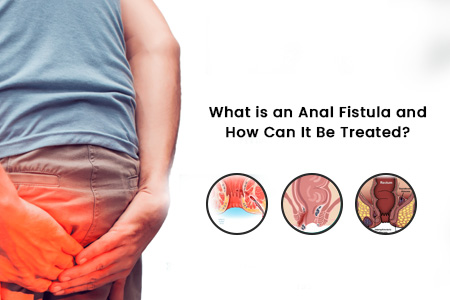An anal fistula is a small, infected channel that develops between the end of the bowel (rectum or anus) and the skin around the anus. It’s often the result of an infection in an anal gland that didn’t heal properly, leading to a collection of pus (abscess) that forms a tunnel from inside the anus to the outer skin. This condition can be uncomfortable and may cause pain, discharge, and irritation. In some cases, it may lead to recurrent infections or complications if not treated effectively.
Understanding the causes, symptoms, and treatment options for an anal fistula is essential for early diagnosis and effective treatment.
Causes of an Anal Fistula
An anal fistula usually develops as a result of an infection that forms an abscess near the anus. The infection may be caused by:
Blocked anal glands: The glands inside the anus can become clogged, leading to infection and the development of a fistula.
Chronic inflammatory conditions: Diseases like Crohn’s disease (a chronic inflammatory bowel disease) can increase the risk of fistula formation due to inflammation in the bowel and surrounding tissues.
Trauma: Injuries or surgical procedures in the anorectal region can lead to the development of a fistula.
Tuberculosis and sexually transmitted infections (STIs): In rare cases, conditions like tuberculosis or STIs can lead to the formation of a fistula.
Symptoms of an Anal Fistula
The symptoms of an anal fistula can vary depending on the severity, but common signs include:
Pain and swelling around the anus
Pus or blood discharge from an opening near the anus
Irritation and itching in the anal region
Fever or chills, especially if the infection is spreading
Recurrent abscesses that form near the anus
Difficulty passing stools due to pain and discomfort
If you experience any of these symptoms, it’s crucial to seek medical attention to prevent complications like chronic infections or fistula recurrence.
How Can an Anal Fistula Be Treated?
An anal fistula usually requires medical intervention to fully heal. Treatment depends on the severity and complexity of the fistula but may include:
1. Surgical Options
Most anal fistulas require surgery to effectively treat and prevent recurrence. Some of the common surgical procedures include:
Fistulotomy: This is the most common treatment for a simple fistula. During the procedure, the surgeon opens up the fistula channel to allow it to heal from the inside out. This method is effective but may involve a longer recovery period.
Seton Placement: A seton is a surgical thread that is placed inside the fistula to keep it open and allow the infection to drain. This method is often used for more complex fistulas where complete fistulotomy may risk damage to the anal sphincter muscles.
Fibrin Glue: A less invasive option, this involves injecting a special glue into the fistula to close it. While the procedure is simple, it may not be as effective for long-term healing as surgery.
LIFT Procedure (Ligation of Intersphincteric Fistula Tract): This procedure is designed for fistulas that pass through the anal sphincter muscles. The surgeon closes the internal opening of the fistula and removes the infected tract to prevent recurrence while preserving the sphincter muscles.
Advancement Flap Procedure: For complex or recurrent fistulas, this procedure involves covering the internal opening of the fistula with a flap of tissue from inside the rectum to encourage healing and prevent recurrence.
2. Ayurvedic Treatment Options
For those looking for natural or alternative treatments, Ayurvedic therapies can offer a holistic approach to healing anal fistulas. These treatments aim to reduce infection, improve digestion, and strengthen the body’s natural healing mechanisms. Ayurvedic methods often include:
Herbal ointments and poultices: To reduce inflammation and promote healing.
Dietary adjustments: To improve digestion and prevent constipation, which can worsen the condition.
Kshar Sutra Therapy: An ayurvedic technique that involves using medicated threads to gradually heal the fistula without surgery. This method is considered effective for certain types of fistulas and is less invasive than conventional surgery.
Post-Treatment Care
Whether you opt for surgical or ayurvedic treatment, post-treatment care is essential to ensure full recovery and prevent recurrence. Some general tips for recovery include:
Maintain a high-fiber diet: Eating fiber-rich foods can soften stools and reduce strain during bowel movements, which is crucial for preventing irritation of the fistula site.
Stay hydrated: Drinking plenty of water can help prevent constipation.
Practice good hygiene: Keeping the anal area clean can prevent further infections. Use warm water and mild soap, and avoid scrubbing or irritating the area.
Follow your doctor’s advice: It’s important to adhere to the post-operative or post-treatment guidelines provided by your healthcare provider to ensure a smooth recovery.
Conclusion
An anal fistula can be a painful and uncomfortable condition, but with proper diagnosis and treatment, it is highly treatable. Early medical intervention is key to preventing complications and ensuring a successful recovery. For those looking for effective treatment options, Dr. Saraja’s Ayurveda Anorectal Centre is the best ayurvedic hospital for piles and fistula in Hyderabad and the best ayurvedic hospital for piles and fistula in Kukatpally. Their experienced team of specialists provides both conventional and ayurvedic treatment options to ensure a holistic and personalized approach to healing.
If you suspect you have an anal fistula, don’t wait to seek treatment. Consult with experts who can guide you through the most suitable treatment options for your condition and ensure a quick and effective recovery.

